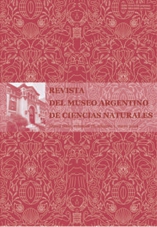Paranita, a new genus of spiders from northeastern Argentina (Araneae, Trachelidae)
Resumen
Palabras clave
Texto completo:
PDF (English)Referencias
Allio, R., A. Schomaker‐Bastos, J. Romiguier, F. Prosdocimi, B. Nabholz & F. Delsuc. 2020. MitoFinder: Efficient automated large‐scale extraction of mitogenomic data in target enrichment phylogenomics. Molecular Ecology Resources 20: 892–905.
Azevedo GF, Bougie T, Carboni M, Hedin M, Ramírez MJ. 2022a. Combining genomic, phenotypic and Sanger sequencing data to elucidate the phylogeny of the two-clawed spiders (Dionycha). Molecular Phylogenetics and Evolution 166(107327): 1–14.
Azevedo G. H. F., B. Tierney, M. Carboni, M. Hedin & M. J. Ramírez. 2022. Convergence, hemiplasy, and correlated evolution impact morphological diversity related to a web-less lifestyle in the two-clawed spiders. Insect Systematics and Diversity 6: 1–14.
Bosselaers, J., & R. Jocqué. 2002. Studies in Corinnidae: cladistic analysis of 38 corinnid and liocranid genera, and transfer of Phrurolithinae. Zoologica Scripta 31: 241–270.
Briscoe, A. G., S. Goodacre, S. E. Masta, M. I. Taylor, M. A. Arnedo, D. Penney, J. Kenny & S. Creer. 2013. Can long-range PCR be used to amplify genetically divergent mitochondrial genomes for comparative phylogenetics? A case study within spiders (Arthropoda: Araneae). PLoS one, 8(5), e62404.
Deeleman-Reinhold, C. L. 2001. Forest spiders of South East Asia: with a revision of the sac and ground spiders (Araneae: Clubionidae, Corinnidae, Liocranidae, Gnaphosidae, Prodidomidae and Trochanterriidae [sic]), Brill, Leiden, 591 pp.
Goloboff, P. A. & S. A. Catalano. 2016. TNT version 1.5, including a full implementation of phylogenetic morphometrics. Cladistics 32, 221–238.
González Márquez M. E., C. J. Grismado & M. J. Ramírez. 2021. A taxonomic revision of the spider genus Meriola Banks (Araneae: Trachelidae). Zootaxa 4936: 1–113.
Haddad, C. R. 2006. Spinotrachelas, a new genus of tracheline sac spiders from South Africa (Araneae: Corinnidae). African invertebrates 47: 85–93.
Haddad, C. R. & R. Lyle. 2008. Three new genera of tracheline sac spiders from southern Africa (Araneae: Corinnidae). African Invertebrates 49: 37–76.
Haddad, C. R., C. Jin, N. I. Platnick & R. Booysen. 2021. Capobula gen. nov., a new Afrotropical dark sac spider genus related to Orthobula Simon, 1897 (Araneae: Trachelidae). Zootaxa 4942: 41–71.
Hoang, D.T., O. Chernomor, A. von Haeseler, B. Q. Minh & L. S. Vinh. 2018. UFBoot2: Improving the ultrafast bootstrap approximation. Molecular Phylogenetics and Evolution 35: 518–522.
Kalyaanamoorthy, S., B. Q. Minh, T. K. F. Wong, A. von Haeseler & L. S. Jermiin. 2017. ModelFinder: Fast model selection for accurate phylogenetic estimates. Nature Methods 14: 587–589.
Liang, Y., Q. Li, H. Q. Yin, H. Li & X. Xu. 2021. Two new species of the genus Otacilia from southern China (Araneae, Phrurolithidae). Acta Arachnologica Sinica 30: 99–105.
Minh, B.Q., H. A. Schmidt, O. Chernomor, D. Schrempf, M. D. Woodhams, A. von Haeseler, & R. Lanfear. 2020. IQ-TREE 2: New models and efficient methods for phylogenetic inference in the genomic era. Molecular Biology and Evolution 37: 1530–1534.
Ramírez, M. J. 2014. The morphology and phylogeny of dionychan spiders (Araneae: Araneomorphae). Bulletin of the American Museum of Natural History, 390: 1–394.
Sica, Y. V., R. D. Quintana, V. C. Radeloff & G. I. Gavier-Pizarro. 2016. Wetland loss due to land use change in the Lower Paraná River Delta, Argentina. Science of the Total Environment 568, 967–978.
Tockner K., S. E. Bunn, C. Gordon, R. J. Naiman, G. P. Quinn & J. A. Stanford. 2008. Flood plains: critically threatened ecosystems. In: N. V. C. Polunin (Ed). Aquatic ecosystems, pp. 45–61. Cambridge University Press, Cambridge, UK.
Wheeler, W. C., J. A. Coddington, L. M. Crowley, D. Dimitrov, P. A. Goloboff, C. E. Griswold, G. Hormiga, L. Prendini, M. J. Ramírez, P. Sierwald, L. Almeida-Silva, F. Alvarez-Padilla, M. A. Arnedo, L. R. Benavides, S. P. Benjamin, J. E. Bond, C. J. Grismado, E. Hasanf, M. Hedin, M. A. Izquierdo, F. M. Labarque, J. Ledford, L. Lopardo, W. P. Maddison, J. A. Miller, L. N. Piacentini, N. I. Platnick, D. Polotow, D. Silva-Dávila, N. Scharff, T. Szűts, D. Ubick, C. J. Vink, H. M. Wood & J. Zhang. 2017. The spider tree of life: Phylogeny of Araneae based on target-gene analyses from an extensive taxon sampling. Cladistics 33: 574–616.
Enlaces refback
- No hay ningún enlace refback.

This work is licensed under a Creative Commons Attribution 3.0 License.

